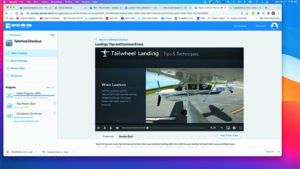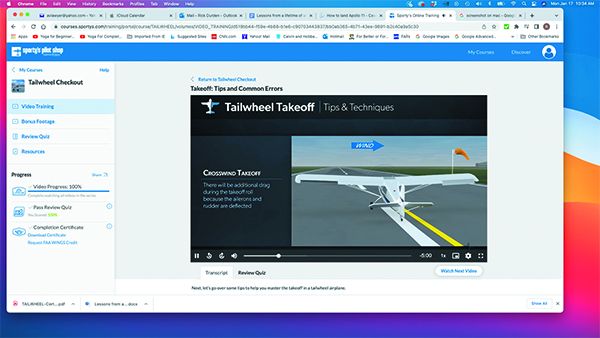Tailwheel airplanes inspire passion at a level probably unmatched in any other segment of the flying community. It’s reflected in the abundance of associated cliches, including “You aren’t a real pilot unless you fly tailwheel.” The airplanes can be incredibly fun and challenging to um, well—land.
The dirty secret about tailwheel pilots is that while they may have a lock on aviation bravado, they wreck their airplanes at a breathtaking rate. When it comes to runway loss of control accidents (RLOC), tailwheel airplanes get rolled into tube-and-fabric or aluminum balls at two to three times the rate of nosewheel airplanes.
A NEED FOR THE BASICS
I’ll put it bluntly: Tailwheel pilots have a love/ohmygawdwhereisthisthinggoing! relationship with their airplanes. In 50-something years of flying and instructing in birds with the steering wheel attached astern I’ve formed the opinion that the high accident rate is a combination of the physics of the center of gravity living aft of the main landing gear and a less than full understanding on the part of the pilots of the significance of those physics and basic aerodynamics.
That’s why I am constantly looking for better ways to teach prospective tailwheel pilots the hows and whys involved with the joys of tailwheel flying—and to get them to understand deep in their individual souls that coming down final faster than 1.3 Vso tops the list of the most foolish things that they can do in one of those flying machines.
A SOLID TRAINING COURSE

I’ve looked at scores of books, articles and videos on the art and science of flying conventional-gear airplanes—many of them quite good. However, I’ve just finished going through what I think is one of the best: Sporty’s “Tailwheel Checkout Course with Patty Wagstaff.”
The $99.99 course is the latest in a string of high-quality training videos created by the former National Aerobatic Champion in association with Sporty’s impressive video production team. The course includes slightly more than two hours of video, with review quizzes throughout, and works on all devices, from laptop through smartphone and tablet to smart TV. Plus, once you buy it, you have access forever—something I value. I think that because it is so content-rich that it should be a long-term resource for any tailwheel pilot seeking to keep the how to and why details of tailwheel flying fresh in mind.

In my conversation with Wagstaff, she pointed out that the course was also created for the tailwheel pilot who hasn’t flown one recently and wants an in-depth refresher before getting back into the airplane. I noted that I found myself replaying sections of the course because I thought they were particularly effective in getting a point across or I picked up something new.
I liked the fact that the course depicts operations in a large cross section of tailwheel airplanes—everything from a Piper J-3 through the DC-3—and also gives a thumbnail history explaining the integral nature of tailwheels (and, before them, tailskids) in aviation. I was reminded why I don’t call tailwheel airplanes taildraggers—because they don’t have tailskids and are much easier to handle on the ground than the true taildraggers flown by the earliest pilots. Hmm, maybe you aren’t a real pilot unless you fly airplanes with tailskids.

The videos are almost all shorter than 10 minutes—they break the material down into easily digestible chunks while delving deeply into important basics such as gyroscopic precession—which means that the airplane is going to turn left dramatically if the tail is forced up rapidly early in the takeoff roll.
PAYS FOR ITSELF
Wagstaff said that the course is intended to complement in-airplane training. I think that it does so we’ll and, as it takes less than three hours to complete—including taking all of the quizzes—is an excellent way for a prospective tailwheel pilot to prepare for the first lesson. I also think that because it so carefully explains the whys of tailwheel flying that it may shave at least an hour out of the checkout process—more than paying for the course.
The videos include a transcript of the narration, allowing a fast review of details. In addition they explain each operation, such as three-point landings, show how to carry it out, give tips and suggestions for the best way to successfully complete the operation and then show what can go wrong and why—as we’ll as how to avoid the pitfalls.
The animation and graphics are particularly effective, in my opinion, in explaining the “why” of something going wrong in a landing.
I think that’s important because I’ve seen pilots draw the wrong conclusion regarding the cause of a problem they’re having—often because of a lack of understanding of the underlying aerodynamics and/or physics.
RESOURCE FOR CFIs
I think that the course has significant value for CFIs because of the step-by-step progression from the basics through advanced operations. I like that it emphasizes risk analysis, notably the common, and often serious, error of coming down final we’ll above Vso for a wheel landing. That point is directly addressed in the section on swerves and how they are worse when the airplane is going fast.
GROUNDLOOPS
Wagstaff addresses groundloops in a matter-of-fact manner—what they are, how they happen and how best to protect yourself and your airplane when the point of no return in a swerve has been passed: Keep the stick all the way aft and stay off the brakes to reduce the risk of flipping over.
I like the course’s emphasis on attitude flying—and Wagstaff’s comment on it: “Attitude flying is basic airmanship.”
The course talks frankly about the limits of tailwheel airplanes—there are times that the wind is simply too strong to operate—and how to recognize when you need to leave the airplane in the hangar.
There are a number of little things of value that pop up repeatedly in the course, such as how high to lift the tail on takeoff (and why) as we’ll as the thought process for flaring and landing, whether three-point or wheel—be patient as you zero out yaw and drift and let the runway come up to you so that you touch down at the slowest possible speed.
CONCLUSION
In my opinion Sporty’s “Tailwheel Checkout with Patty Wagstaff” is a one-stop shop for a well-rounded ground course for the prospective tailwheel pilot as we’ll as a long-term resource for tailwheel pilots and CFIs intent on staying on top of their game. Frankly, considering the extensive video content, I’m amazed that it can be offered for $99.99, and I think it’s we’ll worth the price.


